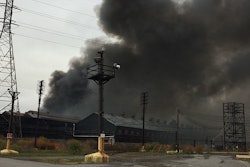Texas law requires the state's largest cities to designate specific routes for the transportation of hazardous materials — a provision aimed at keeping truckloads of volatile chemicals away from busy highways and large population centers.
An investigation by the Houston Chronicle, however, found that the routes in and around the city — home to one of the world's largest petrochemical complexes — haven't been updated in decades.
Although those routes largely moved trucks around crowded areas 40 years ago, those vehicles now navigate some of the country's most notoriously congested roads in close proximity to parks, shopping centers and even the city's football stadium.
Government officials were unsure about why those routes didn't keep up with population trends — and about who has the authority to do so — while the report indicated that federal officials generally neither track the movement of hazardous materials on roads nor enforce rules about transporting them through heavily populated areas.
The report, the seventh in a series about the dangers of Houston's chemical industry, noted that large railroads also frequently transport volatile materials through city neighborhoods.
Texas was home to 19 fatal accidents involving transportation of hazardous materials since 2000 — the most in the nation over that span — and although fatalities were generally limited in those incidents, officials warned that a larger disaster is always imminent.
The Chronicle report, for example, recounted a 1976 accident in which a truck fell off an overpass onto Interstate 610 — which surrounds the city's downtown — and spilled thousands of gallons of anhydrous ammonia.
Six people were killed and 178 injured in that accident. But if a similar crash occurred today?
"It could have wiped out the Galleria," former Houston air quality official Kenneth MacKenzie told the paper, referring to the city's massive west side shopping center.
Report: Outdated Hazardous Materials Routes Endanger Houston
Texas was home to 19 fatal accidents involving transportation of hazardous materials since 2000.
Nov 16, 2016
Latest in Safety
Sensor-Guided Robots Could Boost Lifesaving Combat Casualty Care
September 11, 2025





















